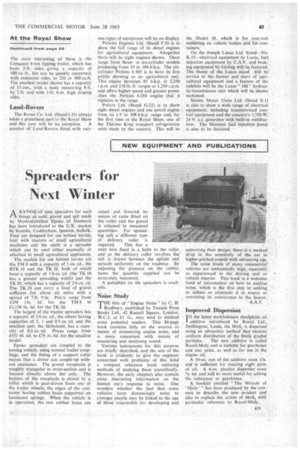Spreaders for Next Winter
Page 65

If you've noticed an error in this article please click here to report it so we can fix it.
A .RANGE of nine spreaders for such r-k things as sand, gravel and salt made by Maskinfabriken Epoke of Denmark has been introduced to the U.K. market by Scandia, Coddenham, Ipswich, Suffolk. Four are designed for use behind lorries, four with tractors or small agricultural machines and the ninth is a spreader which can be used either manually or
• attached to small agricultural appliances.
The models for use behind lorries are the TM 8 with a capacity of I cu. yd., the BTK 10 and the TK 10, both of which have a capacity of 1.6 cu. yd. (the TK 10 has a greater spreading width) and the TK 20, which has a capacity of 2.6 cu. yd. The TK 20 can carry a load of gravel sufficient for about six miles with a spread of 7 ft, 9 in. Prius range from £298 13s. 3d. for the TM 8 to £1.130 Os. 6d. for the TK 20.
The largest of the tractor spreaders has a capacity of 2.6 cu. yd., the others having capacities of 2, 1 and 13.5 cu. yd. and the smallest unit, the Skibelund, has a capacity of in cu. yd. Prices range from £551 Os. 6d. to £79 3s: 6d. for the smallest model.
Epoke spreaders are coupled to the towing vehicle, using normal trailer couplings, and the fitting of a support roller means that a driver can couple-up without assistance. The gravel receptacle is roughly triangular in cross-section and is located directly above the axle. The bottom of the receptacle is closed by a roller which is gear-driven from one of the trailer wheels, the edges of the container having rubber basis supported on. laminated springs. When the vehicle is in operation, the two rubber bases are
raised and lowered by means of carris fitted on the' rollerand the gravel is released in measured quantities. For spreading salt a different type of • delivery roller is required. This has a steel wire fixed in a helix to the roller and as the delivery roller revolves the
salt is drawn' between ;he spirals and spreads uniformly on the roadway. By
adjusting the pressure on the rubber bases the quantity supplied can be accurately measured.
A pamphlet on the spreaders is available.
Noise Study
THE title of "Engine Noise " by C. H. 1 Bradbury, published by Temple Press Books' Ltd., 42 Russell Square, London, W.C.2, at £1 Is., may tend to mislead some potential readers. This 84-page book contains little on the sources or means of minimizing engine noise, and is more concerned with means of measuring and analysing sound.
Various instruments for this purpose are briefly described, and the aim of the book is evidently to give the engineer concerned with problems of this kind a compact reference book outlining methods of studying them scientifically. However, the early chapters also contain some interesting information on the human ear's response to noise. One wonders whether the fact that some vehicles seem distressingly noisy to younger people may be linked to the age of those responsible for developing and approving their design; there is a marked drop in the sensitivity of the ear to higher-pitched sounds with advancing age.
• The noise levels of many commercial' vehicles are undoubtedly high, especially as experienced in the driving seat or • vehicle interior. This book is a welcome fund of information on how to analyse noise, which is the first step in seeking to reduce or eliminate it at source or restricting its conveyance to the hearer. A.A.T. •
Improved Dispersion
IN the latest molybdenum disulphide oil. I additive introduced by Rocol Ltd., Swillington, Leeds, the MoS2 is dispersed using an ultrasonic method that ensures uniform distribution of the finely graded
particles. The new additive is called Rocol-Moly and is suitable for gearboxes and rear axles, as well as for use in the engine oil.
A 10-oz. can of the additive costs 15s. and is sufficient for treating eight pints of oil. A 4-oz. plastics dispenser costs' 7s. 6d. and will be more useful for adding the substance to gearboxes. .
A booklet entitled "The Miracle of Moly*" has been produced by the concern to describe the new product and also to explain the action of MoS, with particular reference to Rocol-Moly.












































































































































